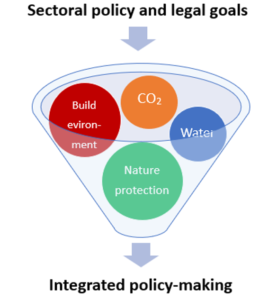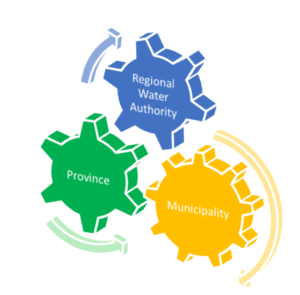WP4.3 – Legal aspects of soil subsidence: responsibilities and liability
Soil subsidence in Dutch peat meadow areas is one of the main challenges in the physical environment, causing a lot of damage to buildings, infrastructure and the environment, now and in the future. The challenge of soil subsidence, however, can be met when governments, which regulate and/or perform activities that cause soil subsidence, effectively address soil subsidence.
WP 4.3 focuses on how environmental law can contribute to a more effective policy- and decision-making by governments. It researches how governments can use the legal instruments at their disposal to effectively address soil subsidence and which improvements, if any, should be made to the existing legal framework for more effective policy- and decision-making. The research also focuses on how liability for damage caused by soil subsidence, or by measures counteracting soil subsidence, could or should be arranged, so that these damages are compensated in a fair and equitable way.
Subsidence as a legal challenge
Soil subsidence is not only a societal challenge, but also a legal challenge. First, to fulfil international, EU and national obligations for the reduction of greenhouse gas emissions, the CO2 emissions from peatlands must be reduced drastically in the (near) future. These reduction targets are enacted in the Paris Agreement and the Dutch Climate Act. Furthermore, EU Regulation 2018/841 (LULUCF Regulation) obliges member states to ensure that emissions from land use, including emissions from managed peatlands, do not exceed removals from other land use sectors. Second, in so far soil subsidence has or could have significant effects on protected species and habitats in protected nature areas, the Birds and Habitats Directives require that appropriate steps are taken.

These legal requirements do not address subsidence as such but do require governments to reduce some of its negative impacts. That in turn means that the underlying processes, most importantly peat oxidation, must be (strongly) mitigated in certain areas. That entails drastic policy changes with considerable societal impact.
Obstacles for effective policy- and decision-making
There are, however, various governance and legal obstacles for such policy changes, which often flow from the cross-sectoral nature of soil subsidence as well as the fragmentation of the Dutch legal system, characterized by a sectoral division of responsibilities over different governments (Van Gils a.o., 2020; Van den Ende, 2022). Soil subsidence intersects with various policy domains, most importantly spatial planning, nature protection and water management. Reducing (the impacts of) subsidence therefore requires policy changes in different policy areas, for which different governments are responsible in the Dutch legal system. Municipalities are primarily responsible for spatial planning, provinces are responsible for nature protection; the governments mainly responsible for water management are the regional water authorities (RWAs) for regional waters and the national government for national waters, whereas municipalities are responsible for some aspects of water management in the built environment (an overview is provided in the paper).

Interlocking competences of municipality, province, and regional water authority
The fragmented nature of the legal system provides obstacles for effective policy change: for example, since RWAs can only make decisions aimed at water-related interests, they cannot reduce drainage in peatlands to reduce CO2 emissions for the reason of mitigating climate change (Van Gils & Groothuijse, 2021). Even if the legal system does not directly provide such obstacles, its fragmentation could still pose obstacles related to the governance of subsidence, such as a lack of procedural and substantive coordination of policies.
Improving the legal framework
What is needed are legal mechanisms or the strengthening thereof that enable effective policy change within the fragmented legal system. Such strategies should not, or not mainly, be aimed at reducing the fragmentation of the legal framework as such. The sectoral division of responsibilities is an integral part of the Dutch legal and constitutional system. Furthermore, different policy domains will always require different policies and these conflicting interests cannot be resolved by institutional changes alone. Possible legal mechanisms that might effectuate policy change are the establishment of a goal regarding the reduction of soil subsidence or CO2 from peatlands, either in national or provincial legislation or as an environmental value and changing sectoral environmental legislation so that it requires that soil subsidence and its impacts are taken into account in all relevant public decisions, especially spatial planning.
The PhD research for WP 4.3 is conducted by Martijn van Gils (UU), under supervision of prof. dr. Marleen van Rijswick and dr. Frank Groothuijse.
Publications
van Gils, M., Stouthamer, E., & Groothuijse, F. (2020). Towards a legal strategy fitting today’s challenge of reducing impacts of subsidence in the Netherlands. Proceedings of the International Association of Hydrological Sciences, 382, 825-829. https://doi.org/10.5194/piahs-382-825-2020
van Gils, M., Groothuijse, F., van Rijswick, H., & Stouthamer, E. (2021). Bodemdaling in Nederlandse veengebieden: Knelpunten voor solide beleid en besluitvorming. Milieu en Recht, 2021/49, 112-120. https://www.recht.nl/vakliteratuur/milieurecht/artikel/502740/bodemdaling-in-nederlandse-veengebieden-knelpunten-voor-solide-beleid-en-besluitvorming
Van Gils, M. & Groothuijse, F. (2021). Juridisch instrumentarium voor de reductie van CO2-emissie uit veengebieden: gefundeerd op slappe bodem? Tijdschrift voor Bouwrecht (TBR) 2021/115, p. 928.
Van Gils, M. (2021). Bodemdaling in stad en ommeland: gevolgen, verantwoordelijkheid en aansprakelijkheid. Milieu en Recht, 2021/49, 341-343.
Van Gils, M.M.W., & Groothuijse, F.A.G. (2022). De juridische (on)mogelijkheden voor het verminderen van broeikasgasemissies uit veen. H2O Waternetwerk, 24 augustus 2022. https://www.h2owaternetwerk.nl/vakartikelen/de-juridische-on-mogelijkheden-voor-het-verminderen-van-broeikasgasemissies-uit-veen
Van Gils, M. & Groothuijse, F. (2021). Annotation to the decision of the Administrative Jurisdiction Division of the Council of State on the extent that the reduction of CO2 emissions from peat soils, partly in view of the Paris Climate Agreement, included in the determination of a water level decision by the regional water authority, ABRvS 15 September 2021, case number ECLI:NL:RVS:2021:2077, Administratiefrechtelijke beslissingen 2021/319.

